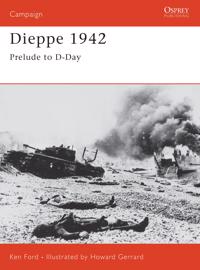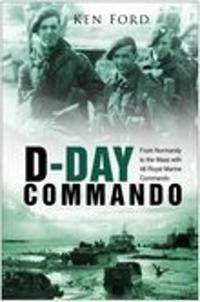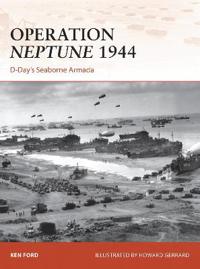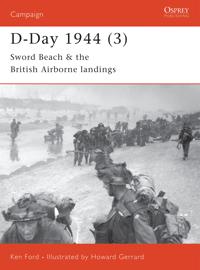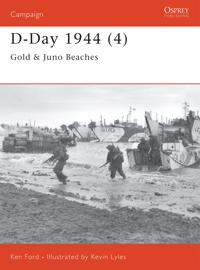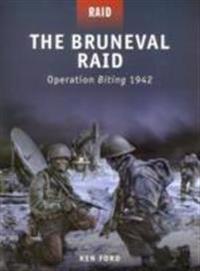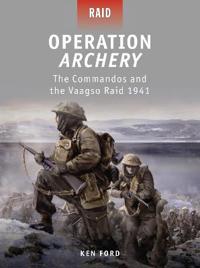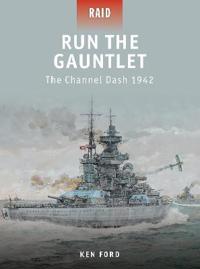The Mareth Line 1943 (Pocket)
avKen Ford, Steve Noon, Ken Ford
ISBN: 9781780960937 - UTGIVEN: 201210The battle of El Alamein saw the shattering of Germany's hopes for victory in North Africa and from this point on the end was inevitable. In the six months that passed before the final surrender there was much hard fighting, as the defeated German and Italian armies sought to hold off the encroachin[...]
Dieppe 1942 (Pocket)
avKen Ford, Howard (ILT) Gerrard, Ken Ford
ISBN: 9781841766249 - UTGIVEN: 2003-07There is no doubt that the raid in force on Dieppe in August 1942 was one of the most controversial episodes of the Second World War. The high number of casualties and prisoners taken led to much recrimination. On the face of it the raid was an unmitigated disaster, with none of the objectives achie[...]
Gazala 1942 (Pocket)
avKen Ford, John (ILT) White, Ken Ford
ISBN: 9781846032646 - UTGIVEN: 2008-05Gazala was Rommel's greatest victory in World War II (1939-1945). After a period of stalemate in the desert war, during which both the British Eighth Army and the Afrika Korps had rested and regrouped, he carried out a daring flanking movement around the strong Allied defensive position. The British[...]
Ford Thunderbird & Mercury Cougar Automotive Repair Manual (Pocket)
avKen Freund, John Harold Haynes, Ken Freund
ISBN: 9781563923111 - UTGIVEN: 1998-06D-Day Commando (Pocket)
avKen Ford
ISBN: 9780750940047 - UTGIVEN: 2005-06Based on eyewitness accounts, official unit war diaries and published and unpublished sources and supported by a selection of maps, line drawings and archive photographs, Ken Ford offers a gripping and authoritative history of 48 Royal Marine Commando.[...]
Operation Neptune, 1944 (Häftad)
avKen Ford
ISBN: 9781472802712 - UTGIVEN: 2014-02This is the story of Operation Neptune was, of course, more than just a tale of planning, building and logistics. It had action a-plenty and the emotive tales of bravery, ingenuity and determination by the crews of the ships involved brought credit to the naval traditions of the Allied nations. Batt[...]
D-Day 1944 (Häftad)
avKen Ford
ISBN: 9781841763668 - UTGIVEN: 200207On the eastern flank of the Allied landings in Normandy was Sword Beach, which was the responsibility of the British 3rd Division. Their objectives for D-Day were to join up with the Canadians landing on Juno and capture the town of Caen. In addition, they were to link up with the British airborne f[...]
D-Day 1944 (Häftad)
avKen Ford
ISBN: 9781841763682 - UTGIVEN: 200211The beaches codenamed Gold and Juno constituted the western section of the British sector of the landings. This title explores the D-Day objectives for the troops landing on these two beaches, which included the capture of the town of Arromanches. They were also tasked with the capture of Bayeux and[...]
Caen 1944 (Häftad)
avKen Ford
ISBN: 9781841766256 - UTGIVEN: 200408The largest city in Normandy, Caen's position at the extreme left of the Allied beachhead gave it major strategic value for Allies and Germans alike. With the German defendants determined that the city should be held at all costs, General Montgomery's fight for Caen became a long and bloody battle o[...]
Falaise, 1944 (Häftad)
avKen Ford
ISBN: 9781841766263 - UTGIVEN: 200503The battle around Falaise in Normandy during August 1944 saw the destruction of the German Seventh army; this title details the chain of events which led to the German retreat and the ensuing liberation of France. The British and American breakout battles had released motorised units to wage a more [...]
The Bruneval Raid (Pocket)
avKen Ford, Howard (ILT) Gerrard, Alan (ILT) Gilliland
ISBN: 9781846038495 - UTGIVEN: 2010-08In the darkest days of World War II, the British planned a daring airborne operation to capture the secret of the new German radar. Lead by Major John Frost, a company of paratroopers dropped into Bruneval on the French coast, and quickly neutralized a small German garrison. Then began a desperate f[...]
Operation Archery (Pocket)
avKen Ford, Howard Gerrard, Alan Gilliland
ISBN: 9781849083720 - UTGIVEN: 201106"Operation Archery: The Commandos and the Vaagso Raid, 1942".
Run the Gauntlet (Pocket)
avKen Ford
ISBN: 9781849085700 - UTGIVEN: 201202"Run the Gauntlet: The Channel Dash 1942".
The Rhineland 1945 (Pocket)
avKen Ford
ISBN: 9781855329997 - UTGIVEN: 2000-10Known as the last great 'stand-up fight' of the Second World War (1939-1945), the battle for the Rhineland was brutal in the extreme. Eisenhower's 'broad front' policy called for the whole of the Rhineland to be taken before pushing his troops across the Rhine and into Germany itself. The Germans op[...]


